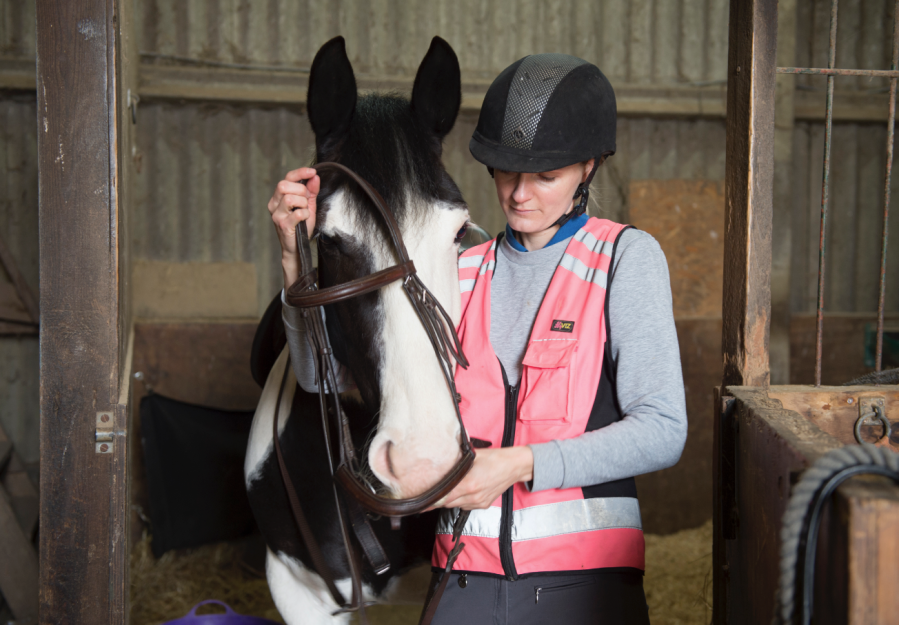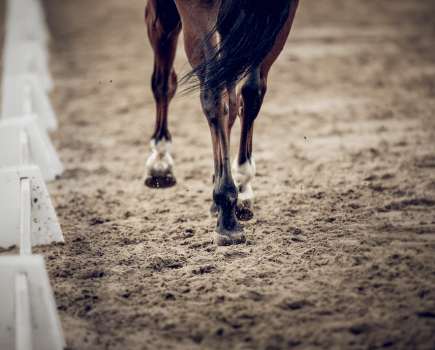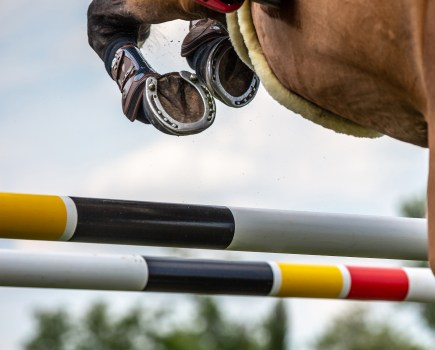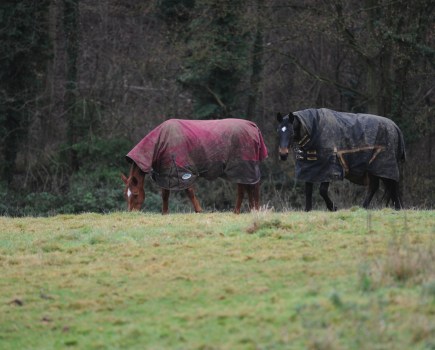We horsey people think (and talk) about saddle fit a lot — but what about the bridle? Both are essential items of horse tack and they have one thing in common: if they don’t fit correctly, they will cause your horse discomfort and affect the way they move and behave. So correct bridle fit is in your horse’s best interest (and yours).
A poor-fitting bridle puts pressure on sensitive facial areas on the horse’s head. Taking the time to run through some basic bridle fit checks to ensure the one you’re using is a good match will help your horse to be as comfortable as possible.
Sometimes, a horse or pony may be between sizes — they could be a large size but need shorter cob-sized cheekpieces for example — and don’t be fooled into thinking that using a padded noseband or shaped headpiece is a quick fix.
How to fit a bridle
In the following video, Diana Fisher from Woolcroft Saddlery, who is a Society of Master Saddlers registered saddle fitter, explains how to correctly fit a bridle.
Bridle fit: headpiece and cheekpieces
About the headpiece: “We really need to make sure that there’s no tightness at the TMJ joint (Temporomandibular joint, learn more about this below) and that the browband is big enough, not pulling the bridle over the ears,” advises Diana.
About the cheekpieces: “Ideally we’d like the buckle to be in line with the horse’s eye or just slightly under. To do that, I would change the cheekpiece to a shorter cheekpiece,” says Diana.
On the horse being fitted in the video, a shorter cheekpiece means the buckle is sitting is line with the eye and the buckle on the throatlash.
“The throatlash you need to be able to get three fingers in. You don’t want that too tight,” adds Diana.
Bridle fit: the noseband
This shouldn’t touch the horse’s cheekbone. If it does and it kept moving, “it would eventually rub and make him sore. Also there are a couple of veins just underneath the cheekbone and if the noseband was done up tight and trapped those veins, the horse would probably cross his jaw and fight it in some way or chuck his head. Those veins are very important that we don’t crush them,” explains Diana.
“I usually make sure I have a finger to a finger-and-a-half [between the cheekbone and noseband]. The problem we have sometimes, if you have a horse with a short distance between the cheekbone and the bit, you have to compromise and just go to one finger [between the cheekbone and noseband].
“What we’ve also got to be careful about with a noseband is that it sits behind the cheekbone, not forward. You do see a lot of horses with a noseband that’s a little short on the front and so it pulls it forward on to the cheekbone. We don’t want that. It’s important to make sure that it’s one finger width behind the cheekbone,” adds Diana.
“Do the noseband up nice and snug but not too tight; I can easily get my finger in there. If you do the noseband up too tight, you’re going to get pressure on the nasal bone, which is not good because a horse will just fight that. Any pressure that irritates a horse they will try and fight it by throwing the head, crossing the jaw or pulling down at you.”
7 signs your horse’s bridle fit is incorrect
- They are tense when ridden
- They are overly reactive and spooky when ridden
- They are unwilling to go forwards and take a contact
- The refuse to jump
- Rearing
- Showing discomfort when touched in certain areas on the head, such as the ears or poll
- Over time you may notice a change in muscle development, such as a ewe (upside down) neck.
This list isn’t exhaustive, and of course they can all be caused by other issues too. To you be confident in your horse’s bridle fit, understanding the anatomy of their head, where the nerves and particularly sensitive areas are, is key to getting it right.
All about the Temporomandibular joint (TMJ)
The TMJ is the junction of the lower jaw (mandible) with the skull, and it has the most proprioceptive nerves in your horse’s entire body. It contributes to their spatial awareness-proprioceptive nerve endings, which make them aware of their movement and space around them.
“When a horse can’t move their lower jaw, they will struggle with body awareness, which results in poor movement and performance,” says Dr Tracy Crook, a chartered veterinary physiotherapist who treats horses and riders at ChilternVetPhysio.
The TMJ also allows movement of the lower jaw on the upper jaw, so your horse can:
- Chew from side to side
- Open their mouth to eat and yawn
- Open up their airways via the forward movement of the lower jaw on the upper jaw as their head flexes.
TMJ and the impact of bridle fit
“If you fasten your horse’s noseband too tightly, they’ll be unable to move their jaw. This can happen whatever type of noseband you use, so look at loosening the noseband by a hole or two,” advises Tracy. “Also, question whether they really need a flash noseband, for example, and consider trying them in a simple cavesson instead.
“A noseband that is incorrectly positioned can restrict your horse’s breathing by closing their nostrils. A horse is an obligate nostril breather and cannot breathe through the mouth. In addition, a tight noseband can compress the mucous membranes of the mouth against your horse’s teeth, resulting in discomfort or even pain.”
If this area is compromised, it will have a massive impact on a horse’s way of going.
“It can affect balance and they may struggle with lateral movements,” says Tracy. “To try to relieve the tension in their muscles, your horse may go behind the bit, hollowing their back and shortening their stride.”
A horse’s ears and bridle fit
Your horse 14 muscles that they use to control the position of their ears to communicate with other horses and to express themselves. As a prey animal, their ears are highly sensitive to the sound of predators approaching so they can flee from danger. There are also many nerves that come out of the top of a horse’s skull to their ears.
“If a headpiece is positioned incorrectly it can pinch the nerves and muscles, causing discomfort,” warns Tracy. “A shaped headpiece that fits around the ears will help to avoid pressure on this area. A tight broadband can pull the whole bridle forward onto the sensitive area at the back of your horse’s ears. Check you can comfortably run a finger around the inside edge of the browband.”
Pressure at the base of the horse’s ears compresses the sensory nerve endings. This reduces the circulation to the ear muscles, causing a lactic acid build-up in the muscles and pain.
“If your horse can’t move their ears to hear effectively, it causes anxiety and their stress levels will rise,” explains Tracy. “Other signs to look out for include not liking ears being touched, being head shy and having an abnormal ear position.”
Cranial nerves in a horse’s head
Cranial nerves supply energy to the muscles of the horse’s head and provide information to the brain regarding sensations of pressure, touch, and hot and cold temperatures. When it comes to bridle fit, consider the following advice from Tracy:
- The position of the cheekpieces relative to the nerves that run down your horse’s face may cause pressure and pinching. Ideally, the cheekpiece should fasten halfway down the strap on the headpiece, or in line with the edge of your horse’s eye.
- If you use a curb chain, fastening it too tight may result in pressure on the mental nerve that exits the lower jaw close to the end of your horse’s mouth.
- A standard cavesson noseband needs sufficient clearance below the bottom ends of your horse’s cheekbones. There are a number of arteries where the cheekbones finish, so for greater comfort, this width will help you to make sure that your noseband misses them.
“Excessive pressure on any one of these nerves from an incorrectly fitted bridle or buckle will result in pain and discomfort, and may impair the transmission of nerve impulses from the brain to the muscles,” says Tracy. “A loss of function may affect the muscles around the ears and poll, the orbicularis occuli muscle that closes the eyelids, the muscles on the side of the face, upper lip, nostrils and lower lip or chin, depending on where the pressure on your horse’s head is.”
Bridle fit and the hyoid apparatus
A horse’s tongue attaches to the hyoid apparatus at the back of their mouth. There are a number of small muscles that connect the two hyoid bones to the TMJ and poll.
There’s a direct connection from the tongue to the sternum via the sternohypid muscle, and the shoulder along the bottom of the horse’s neck via the omohyoid muscle. There’s also connective tissue (fascia) that runs from the hyoid apparatus to your horse’s hind legs.
“Tension in the tongue creates tension in the sternum, making it difficult for a horse to lift their back and they’ll struggle with collection,” explains Tracy. “The hyoid apparatus is intimately connected to the airways and affects breathing, plus it’s also connected to the hindlegs, which can impact on the horse’s flexibility and range of movement.
“When your horse’s tongue is free and soft, their movement will be freer with better stride length and balance.”
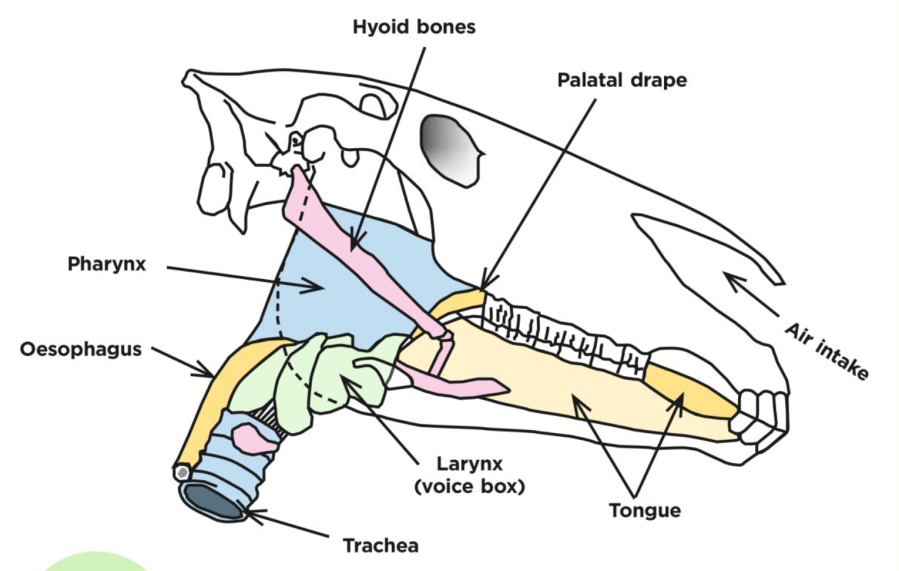
The poll and bridle fit
Your horse’s poll is immediately behind their ears at the very top of their head. It’s made up of a small bony area and muscles which attach the base of the skull to the first two to three neck vertebrae, and others that run from the base of the skull to the base of the neck.
“Although the poll area is relatively small, it’s key to a horse’s freedom and movement,” states Tracy. “When they act together, the poll muscles elevate your horse’s head. Acting separately, they flex the head left or right.”
The poll can be affected by bridle fit in the following ways:
- An incorrectly shaped or padded headpiece that doesn’t suit the shape of your horse’s head may cause discomfort. Check it’s cut away in the right place so it can accommodate ears.
- Having the bit too high in your horse’s mouth will increase the amount of poll pressure. “Many people have been taught that there should be two wrinkles at each side of your horse’s mouth, but this can cause too much pressure for a lot of horses,” advises Tracy. “Try dropping the bit down a hole and see the reaction from your horse.”
- The type of bit you use can put varying pressure on to the poll. Consider trying a different bit if your horse doesn’t appear to be happy in their current one.
- The rider’s hands and contact on the rein create poll pressure, so having regular lessons with an experienced trainer can help you work on this area if you need to.
“Pressure on the poll area causes pain and discomfort and, unsurprisingly, has a big negative effect on your horse’s attitude and way of going. Ways in which this manifest include a reluctance to accept the contact and an unwillingness to go forward or flex at the poll,” says Tracy.
“Excessive poll pressure can also result in a high head carriage or going behind the bit — essentially your horse will do anything to try and relieve the pressure. For example, they may toss their head about to try to alleviate the discomfort they feel. As a general rule, if there’s tension at the poll there will be tension in the rest of the horse’s body too.”
Main image © Your Horse Library/Lucy Merrell; video & diagram © Your Horse Library/Kelsey Media

